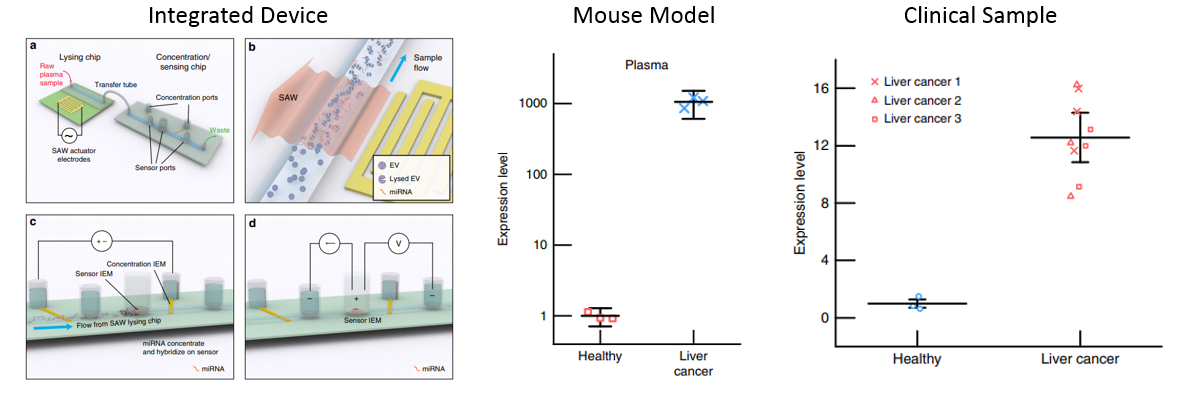Integrated Nanomembrane Biochip Platform for Molecular Detection and Quantification

We have invented an array of microfluidic technologies based on embedded ion-selective membranes and hydrogels in a biochip. Under an electric field, these membranes exhibit internal and external concentration polarization phenomena, which we have exploited to achieve isolation, concentration, detection and quantification of charged target molecules like nucleic acids and proteins. For example, short-range (within a 1-nm Debye length) ion depletion is used to create a nanoscale interfacial region such that the presence of target molecules, captured by surface-functionalized probes, can produce an amplified current or voltage signal (~V compared to ~10 mV in electrochemical sensing). We have integrated these ionic circuits with microfluidic and electronic circuits in our multiplex biochips to realize a push-button, sample-to-answer, low-cost, and portable diagnostic platform [Figs. A and B]. Currently, our polymer-based integrated chip is capable of processing heterogeneous physiological samples (plasma and ascitic fluids) to isolate and detect 5 target nucleic acids in 30 minutes with two-mismatch specificity and 100 fM sensitivity (Figs. C and D). We have developed rapid prototyping methods for the membrane embedded polymer biochips based on 3-D printing and micro-milling. We are also developing a manufacturing strategy based on injection molding. The sensing platform has been successfully tested against pathogens such as dengue virus, E.coli, Brucella and against host biomarkers (miRNA) for pancreatic, liver, oral, breast and ovarian cancers with mouse and human samples.
Electrokinetic Technologies for Rapid Pretreatment: Ion Depletion and Wien Effect

Using membrane electrokinetics and ionic transistors, the local ionic strength and pH on a chip can be precisely controlled. The resulting high field can be used to extract high electrophoretic mobility molecules from a flowing stream or to carry out free-flow electrophoretic separation of molecules and exosomes from like-charge molecules. Nucleic acid isolation is used to remove inhibitors like RNase and Calcium in PCR based assays. The control of pH and the establishment of a pH gradient on the chip is achieved with a bipolar membrane that can split water by the Wien Effect. The latter is used to achieve on-chip isoelectric separation and focusing of proteins.
High-Yield Surface Acoustic Wave Lysing and Molecular Extraction

We have designed a Surface Acoustic Wave technology to lyse cells, exosomes and lipoproteins. This chemical-free and absorption-free lysing technology eliminates additional steps to extract the molecular cargo from the lysing buffer or a solid-phase affinity substrate, which are low-yield processes. This is a key reason behind the high-yield feature of our integrated platform. The technology is based on scattering of the surface acoustic waves into bulk acoustic waves with large compression/expansion amplitudes.